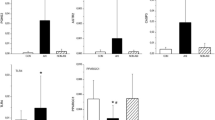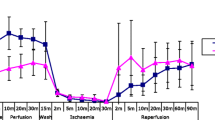Abstract
The aim of this study was to investigate the expression of the immediate early genes (IEGs),c-fos andc-jun, in the rat kidney and liver in two types of hemorrhage shock/ resuscitation models. In the first group, hemorrhagic shock was induced by the withdrawal of blood through the carotid artery. A mean arterial blood pressure (MAP) of 40mmHg was maintained for 1h before blood was reperfused. In the second group, the MAP was maintained at the same level for 2 h. Animals were resuscitated with Ringer’s lactate solution. In the first group, a rapid and transient induction ofc-fos andc-jun mRNAs in both the liver and kidney was observed, peaking 0 to 2h after reperfusion. In the second group, a more protracted pattern of induction was evident in both organs. In both models, the induction ofc-fos mRNA was distinctly different in the liver and kidney. These results indicated, first, that with respect to IEG expression, organs respond differently to a systemic shock/resuscitation stimuli, and second, that alterations in the pattern of IEG expression might represent an indication of the degree of organ damage or the repair processes subsequent to hypotension/reperfusion.
Similar content being viewed by others
References
Baue AE (1983) Multiple, progressive or sequential systems failure: a syndrome of the 1970s. Arch Surg 110:779–781
Faist E, Baue AE, Dittmer M, Hebere G (1983) Multiple organ failure in polytrauma patients. J Trauma 23:775–787
Ozawa K, Aoyama H, Yasuda K, Shimahara Y, Nakatani T, Tanaka J, Yamamoto M, Kamiyama Y, Tobe T (1983) Metabolic abnormalities associated with postoperative organ failure: a redox theory. Arch Surg 118:1245–1251
Bellamy RF, Pedersen DC, DeGuzman LR (1984) Organ blood flow and the cause of death following massive hemorrhage. Circ Shock 14:113–127
Guyton AC (1981) Textbook of Medical Physiology. Saunders, Philadelphia, pp 332–419
Wang P, Hauptman JG, Chaudry IH (1990) Hepatocellular dysfunction occurs early after hemorrhage and persists despite fluid resuscitation. J Surg Res 48:464–470
DePalma RG, Levey S, Holden WD (1970) Ultrastructure and oxidative phosphorylation of liver mitochondria in experimental hemorrhagic shock. J Trauma 10:122–134
Iwata S, Tanaka A, Ozawa K (1992) Alterations in the proton ATPase activity of rat liver mitochondria after hemorrhagic shock. J Lab Clin Med 120:420–427
Rasmussen HH, Ibels LS (1982) Acute renal failure. Multivariate analysis of causes and risk factors. Am J Med 73:211–218
Ratcliffe PJ, Mooden CTW, Holloway PAH, Ledingham JGG, Radda GK (1986) Acute renal failure in haemorrhagic hypotension: cellular energetics and renal function. Kidney Int 30:355–360
Dobyan DC, Nagle RB, Bulger RE (1977) Acute tubular necrosis in the rat kidney following sustained hypotension. Lab Invest 37:411–422
Morgan JI, Curran T (1991) Stimulus-transcription coupling in the nervous system: involvement of the inducible protooncogenes fos and jun. Annu Rev Neurosci 14:421–451
Curran T, Franza BR (1988) Fos and Jun. The AP-1 connection. Cell 55:395–397
Franza BR, Rauscher FJ, Josephs SF, Curran T (1988) The fos complex and fos related antigen recognize sequence elements that contain AP-1 sites. Science 239:1150–1153
Smeyne RJ, Vendrell M, Hayward M, Baker SJ, Miao GG, Schilling K, Robertson LM, Curran T, Morgan JI (1993) Continuousc-fos expression precedes programmed cell death in vivo. Nature 363:166–169
Maki A, Berezesky IK, Fragnoli J, HolbrooK NJ, Trump BF (1992) Role of [Ca2+]i in induction ofc-fos, c-jun and c-myc mRNA in rat PTE after oxidative stress. FASEB J 6:919–924
Le F, Wilce PA, Cassady I, Hume DA, Shanley BC (1990) Acute administration of ethanol supresses pentylenetetrazole-induced c-fos expression in rat brain. Neurosci Lett 120:271–274
Le F, Wilce PA, Hume DA, Shanley BC (1992) Involvement of r-aminobutyric acid and N-methyl-D-aspartate receptors in the inhibitory effects of ethanol on pentylenetetrazole-inducedc-fos expression in rat brain. J Neurochem 59:1309–1315
Matsumoto I, Leah J, Shanley B, Wilce P (1993) Immediate early gene expression in the rat brain during ethanol withdrawal. Mol Cell Neurosci 4:485–491
Cowley BD, Chadwick LJ, Grantham JJ, Calvet JP (1989) Sequential protooncogene expression in regenerating kidney following acute renal injury. J Biol Chem 264:8389–8393
Rosenberg ME, Paller MS (1991) Differential gene expression in the recovery from ischemic renal injury. Kidney Int 39:1156–1161
Safirstein R, Price PM, Saggi SJ, Harris RC (1990) Changes in gene expression after temporary renal ischemia. Kidney Int 37:1515–1521
Schiaffonati L, Rappocciolo E, Tacchini L, Cairo G, Bernelli-Zazzera (1990) Reprogramming of gene expression in postischemic rat liver: induction of protooncogenes and hsp 70 gene family. J Cell Physiol 143:79–87
Marterre WF, Kindy MS, Carney M, Landrum RW, Strodel WE (1991) Induction of the protooncogenec-fos and recovery of cytosolic adenosine triphosphate in reperfused liver after transient warm ischemia: effect of nitrone free-radical spin-trap agents. Surgery 110:184–191
Herbst H, Milani H, Schuppan D, Stein H (1991) Temporal and spatial patterns of proto-oncogene expression at early stages of toxic liver injury in the rat. Lab Invest 65:324–333
Thompson NL, Mead JE, Goyette M, Shank PR, Fausto N (1986) Sequential proto-oncogene expression during rat liver regeneration. Cancer Res 46:3111–3117
Dragnow M, Young D, Hughes P, MacGibbon G, Lawlor P, Singleton K, Sirimanne E, Beilarnz E, Gluckman P (1993) Isc-jun involved in nerve cell death following status epilepticus and hypoxic-ischaemic brain injury? Mol Brain Res 18:347–352
Goto S, Matsumoto I, Kamada N, An Bui, Saito T, Findlay M, Pujic Z, Wilce P (1994) The induction of immediate early genes in postischemic and transplanted livers in rats; its relation to organ survival. Transplantation 58:840–845
Werle JM, Cosby RS, Wiggers J (1942) Observations on haemorrhagic hypotension and haemorrhagic shock. Am J Physiol 136:401–420
Wang P, Chaudry IH (1991) Crystalloid resuscitation restores but does not maintain cardiac output following severe hemorrhage. J Surg Res 50:163–169
Hsu SM, Raine L, Fanger H (1981) Use of avidin-biotinperoxidase complex (ABC) in immunoperoxidase techniques. J Histochem Cytochem 29:577–580
Vogt PK, Bos TJ (1990) JUN: oncogene and transcription factor. Adv Cancer Res 55:2–36
Kovary K, Bravo R (1991) Expression of different Jun and Fos proteins during the G0-to-G1 transition in mouse fibroblasts: In vitro and in vivo associations. Mol Cell Biol 13:2451–2459
Sonnenberg JL, Macgregor-Leon, Curran T, Morgan JL (1989) Dynamic alterations occur in the level and composition of transcription factor AP-1 complex after seizure. Neuron 3:359–365
Cole AJ, Saffen JM, Baraban JM, Worley PF (1989) Rapid increase in immediate early gene mRNA in hippocampal neurons by synaptic NMDA receptor activation. Nature 340:474–476
Rogue P, Vicendon (1992) Dopamine D2 receptor antagonists induced immediate early genes in the rat striatum. Brain Res Bull 29:469–472
Gass P, Herdegen T, Bravo R, Kiessling M (1992) Induction of immediate early gene encoded proteins in the rat hippocampus after bicuculline-induced seizures. Differential expression of KROX-24, FOS and JUN. Neuroscience 48:315–324
Author information
Authors and Affiliations
Rights and permissions
About this article
Cite this article
Saito, T., Matsumoto, I., Goto, S. et al. The differential induction of two immediate early genes,c-fos andc-jun, after systemic hypovolemic shock/resuscitation in the rat liver and kidney. Surg Today 28, 608–617 (1998). https://doi.org/10.1007/s005950050193
Received:
Accepted:
Issue Date:
DOI: https://doi.org/10.1007/s005950050193




